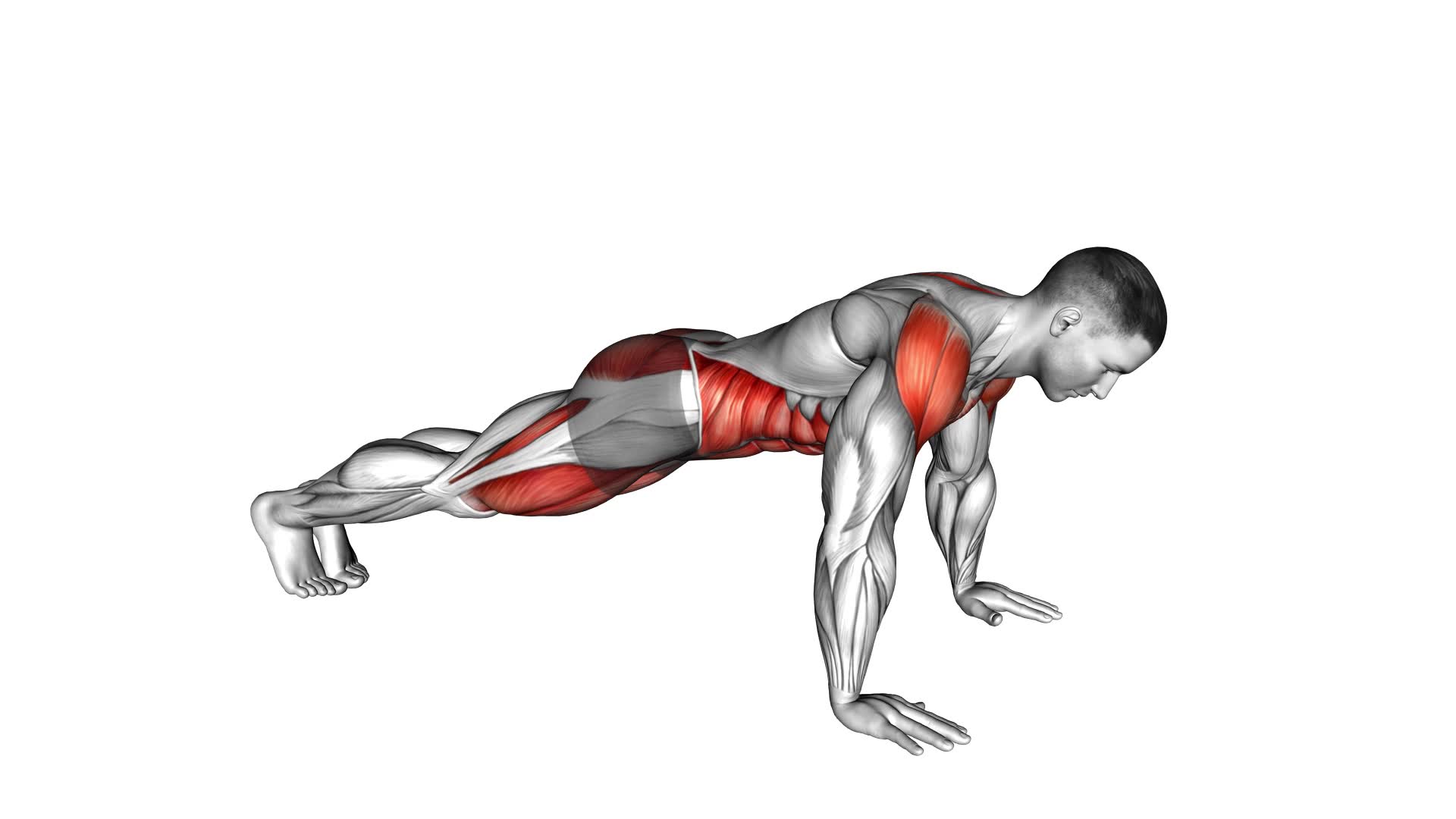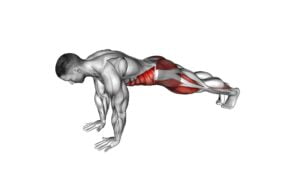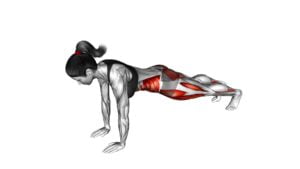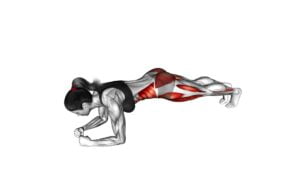Front Plank to Toe Tap (male) – Video Exercise Guide & Tips

Are you looking for an effective exercise to strengthen your core? Look no further than the front plank to toe tap! This exercise targets your abdominal muscles and improves stability.
Watch This Exercise Video
In this video exercise guide, you'll learn the proper form and technique specifically for males. Maximize your results with our expert tips and challenge yourself with variations.
Avoid common mistakes and get ready to take your core strength to the next level!
Key Takeaways
- The Front Plank to Toe Tap exercise improves stability, balance, and targets abdominal muscles.
- Proper form and technique for males include starting in a high plank position, engaging the core and glutes, and lifting one foot off the ground to tap it to the side.
- Tips for maximizing results include maintaining proper form, incorporating advanced variations, consuming a balanced diet, and including cardio exercises for overall fitness.
- Variations to challenge the core include using a stability ball or unstable surface, starting on knees for beginners, decreasing range of motion, and gradually increasing difficulty as you progress.
Benefits of the Front Plank to Toe Tap
The Front Plank to Toe Tap exercise offers you a range of benefits for improving balance and increasing core strength. By engaging your core muscles, this exercise helps to stabilize your body and improve your overall balance. It specifically targets the muscles in your abdomen, lower back, and hips, which are essential for maintaining stability and preventing injuries.
When you perform the Front Plank to Toe Tap, you're actively engaging your core muscles to hold your body in a straight line. This not only strengthens your core, but also improves your body's ability to maintain balance during various movements and activities.
Additionally, the Front Plank to Toe Tap exercise helps to improve the coordination between your upper body and lower body. As you tap your toes, you're challenging your core stability and enhancing your proprioception, which is your body's awareness of its position in space. This can translate into improved balance and coordination in other exercises and daily activities.
Now that you understand the benefits of the Front Plank to Toe Tap exercise for improving balance and increasing core strength, let's move on to the next section, which will focus on the proper form and technique for males.
Proper Form and Technique for Males
Mastering proper form and technique for males is crucial in maximizing the benefits of the Front Plank to Toe Tap exercise. Whether you're a beginner or an advanced athlete, understanding the modifications and advanced variations can help you perform the exercise correctly and efficiently.
For beginners, it's important to start with the basic version of the exercise. Begin in a high plank position with your hands directly under your shoulders and your feet hip-width apart. Engage your core and glutes, and keep your body in a straight line from head to toe. Slowly lift one foot off the ground and tap it to the side, then return it to the starting position. Alternate between your left and right foot for the desired number of repetitions.
For advanced athletes, there are several variations to challenge your core and increase the difficulty of the exercise. You can add a stability ball or a Bosu ball under your feet to create an unstable surface, forcing your core muscles to work harder to maintain balance. Another option is to perform the exercise with sliders, placing your feet on the sliders and sliding them out to the side instead of tapping.
Remember to maintain proper form throughout the exercise, keeping your core engaged and your body in a straight line. By mastering the proper form and technique, you can maximize the benefits of the Front Plank to Toe Tap exercise and enhance your overall fitness level.
Tips for Maximizing Your Results
To maximize your results with the Front Plank to Toe Tap exercise, focus on maintaining proper form and incorporating advanced variations to challenge your core muscles. Proper form is essential for engaging the right muscles and avoiding injury. Keep your body in a straight line from head to toe, engage your core by pulling your belly button towards your spine, and avoid sagging or lifting your hips too high.
As you become more comfortable with the exercise, you can start incorporating advanced variations such as lifting one leg off the ground, adding a knee tuck, or using a stability ball. These variations will further engage your core muscles and increase the intensity of the exercise.
In addition to exercise, nutrition plays a crucial role in maximizing your results. It's important to fuel your body with the right nutrients to support muscle growth and recovery. Aim to consume a balanced diet that includes lean proteins, healthy fats, and complex carbohydrates. Stay hydrated by drinking plenty of water throughout the day.
To achieve a complete workout and maximize your results, it's also important to incorporate cardio exercises into your routine. Cardiovascular exercise helps burn calories, improve cardiovascular health, and increase endurance. You can include activities such as running, cycling, swimming, or jumping rope. Aim for at least 150 minutes of moderate-intensity cardio or 75 minutes of vigorous-intensity cardio each week.
Variations to Challenge Your Core
To continue challenging your core muscles, you can further intensify the Front Plank to Toe Tap exercise with these variations.
If you're looking for advanced core exercises, try adding a stability ball to the mix. Start by placing your feet on the ball instead of the ground while in the front plank position. This will require more stability and engage your core even further.
Another variation is to perform the exercise on an unstable surface, such as a Bosu ball. Place your forearms on the ball and hold a plank position, then tap your toes to the ground one at a time. This will challenge your core muscles by forcing them to work harder to maintain balance.
For beginners or those who aren't quite ready for the advanced variations, there are modifications available. You can start by performing the exercise on your knees instead of your toes. This will decrease the amount of weight you have to support and make the exercise more manageable. Additionally, you can decrease the range of motion by tapping your toes to the ground at a closer distance.
Remember to always listen to your body and choose the variation that's appropriate for your fitness level. As you progress, gradually increase the difficulty to continue challenging your core muscles.
Common Mistakes to Avoid
Avoid these common mistakes when performing the Front Plank to Toe Tap exercise.
To ensure that you're getting the most out of this exercise and preventing any potential injury, it's important to maintain proper technique throughout.
One common mistake to avoid is letting your hips sag while in the plank position. This puts unnecessary strain on your lower back and reduces the effectiveness of the exercise. Instead, engage your core muscles and keep your body in a straight line from your head to your heels.
Another mistake to watch out for is rushing through the toe tap movement. It's important to perform this movement slowly and with control to fully engage your core muscles. Take your time and focus on maintaining your balance and stability.
Additionally, avoid lifting your leg too high during the toe tap. This can cause your hips to rotate and throw off your alignment. Instead, aim to tap your toe lightly to the ground while keeping your hips stable.
Frequently Asked Questions
How Long Should I Hold the Front Plank to Toe Tap Exercise For?
To progress the front plank to toe tap exercise, start by holding the plank for 10-15 seconds and gradually increase the time as you get stronger.
Remember to engage your core and keep your body in a straight line.
Common mistakes to avoid include sagging your hips or lifting your butt too high.
Aim for proper form and control throughout the exercise for optimal results.
Can I Perform the Front Plank to Toe Tap Exercise Without a Mat?
Yes, you can perform the Front Plank to Toe Tap exercise without a mat. However, it's recommended to use a mat or a soft surface to provide cushioning and support for your wrists and knees.
This exercise targets your core muscles and improves stability and balance. Remember to engage your abs and keep your body in a straight line throughout the movement.
Check out the Video Exercise Guide & Tips {402312} for proper form and technique.
What Is the Recommended Frequency for Doing the Front Plank to Toe Tap Exercise?
To properly perform the front plank to toe tap exercise, it's important to understand the recommended frequency.
The recommended frequency for this exercise is typically three to four times a week. This allows your muscles to rest and recover between sessions.
Consistency is key, so try to stick to a regular schedule.
Remember to listen to your body and adjust the frequency as needed to avoid overexertion or injury.
Can I Modify the Front Plank to Toe Tap Exercise if I Have Wrist Pain?
If you're experiencing wrist pain during the front plank to toe tap exercise, there are a few modifications you can try.
Firstly, you can perform the exercise on your forearms instead of your hands to reduce strain on the wrists.
Alternatively, you can try alternative exercises that don't put as much pressure on the wrists, such as mountain climbers or knee tucks.
Remember to listen to your body and choose modifications that work best for you.
Is the Front Plank to Toe Tap Exercise Suitable for Beginners?
If you're a beginner, the Front Plank to Toe Tap exercise can be quite challenging. However, there are modifications you can make to suit your fitness level.
This exercise is great for developing core strength and stability. By engaging your abs and glutes, you'll improve your overall posture and balance.
It's important to listen to your body and start with simpler variations before progressing to the full exercise.
Conclusion
Incorporating the front plank to toe tap exercise into your routine can provide numerous benefits for males looking to strengthen their core.
By maintaining proper form and technique, you can maximize your results and challenge your core even further with variations.
Avoiding common mistakes will help you achieve optimal results.
So, incorporate this exercise into your fitness routine and watch your core strength improve.

Author
Years ago, the spark of my life’s passion ignited in my mind the moment I stepped into the local gym for the first time. The inaugural bead of perspiration, the initial endeavor, the very first surge of endorphins, and a sense of pride that washed over me post-workout marked the beginning of my deep-seated interest in strength sports, fitness, and sports nutrition. This very curiosity blossomed rapidly into a profound fascination, propelling me to earn a Master’s degree in Physical Education from the Academy of Physical Education in Krakow, followed by a Sports Manager diploma from the Jagiellonian University. My journey of growth led me to gain more specialized qualifications, such as being a certified personal trainer with a focus on sports dietetics, a lifeguard, and an instructor for wellness and corrective gymnastics. Theoretical knowledge paired seamlessly with practical experience, reinforcing my belief that the transformation of individuals under my guidance was also a reflection of my personal growth. This belief holds true even today. Each day, I strive to push the boundaries and explore new realms. These realms gently elevate me to greater heights. The unique combination of passion for my field and the continuous quest for growth fuels my drive to break new ground.







